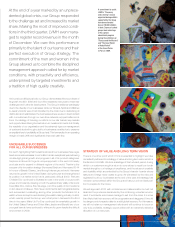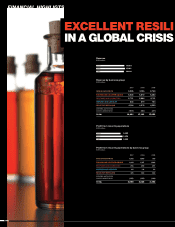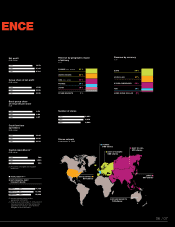Louis Vuitton 2009 Annual Report Download - page 12
Download and view the complete annual report
Please find page 12 of the 2009 Louis Vuitton annual report below. You can navigate through the pages in the report by either clicking on the pages listed below, or by using the keyword search tool below to find specific information within the annual report.
Corporate
governance
The priority objectives of the Board of Directors, the strategic body of LVMH, are to increase the value of the Company
and defend its social interest. Its principal missions are to adopt the major strategies of the company and the Group,
monitor the implementation of those strategies, verify the fair and accurate presentation of information about the
company and the Group, and protect its corporate assets.
The Board of Directors of LVMH Moët Hennessy-Louis
Vuitton guarantees respect for the rights of each share-
holder of its company and ensures that they respect
all their duties.
As part of its mission, it supports the major goal of the
LVMH management which remains, as always, to
ensure the continued growth of the Group and the
continuing enhancement of shareholder value.
The reference for the Company is the AFEP-MEDEF
“Corporate Governance Code for Traded Companies”.
This code can be consulted on the website www.code-
afep-medef.com.
The Board of Directors has adopted a Charter that
spells out the membership, mission, operations and
responsibilities of the Board.
The Board of Directors has two Committees, the
membership, role and missions of which are defined
by internal procedural rules.
The Board of Directors’ Charter and the internal rules
of the Committees are provided to every candidate for
the position of Director, and to the permanent repre-
sentative of any legal entity, before he assumes his
duties.
BOARD OF DIRECTORS
As of December 31, 2009, The Board of Directors was
made up of 18 members, 6 of whom are independent
and free of any interests with respect to the Company.
Members of the Board of Directors must, in accor-
dance with the regulations, personally and directly
own at least 500 shares of LVMH.
The Board of Directors met four times in 2009, on a
written notice of meeting from the Chairman sent to
each of the Directors at least one week before the date
of the meeting. The attendance rate of the members
at meetings averaged 79%.
The Board approved the annual and interim financial
statements and reviewed the Group’s major strategic
guidelines, budget, the implementation of stock option
plans and bonus share allotment plans, authorization
for third party guarantees and various agreements with
related companies, the adoption of the LVMH Group
Code of Conduct and the election of a Vice Chairman.
It also assessed its ability to meet shareholder expec-
tations by reviewing its membership, organization and
operations, and amended its Charter and the internal
rules for the Board Committees.
EXECUTIVE MANAGEMENT
The Board of Directors has decided not to separate
the offices of Chairman of the Board and Chief Execu-
tive Officer and has placed no limits on the power of
the Chief Executive Officer.
On the recommendation of the Chairman and Chief
Executive Officer, the Board of Directors has appointed
a Managing Director who has the same powers as the
Chief Executive Officer.
PERFORMANCE
AUDIT COMMITTEE
The Performance Audit Committee is primarily respon-
sible for ensuring that the accounting principles follo-
wed by the Company and by the Group comply with
the standards in force, reviewing the corporate and
consolidated financial statements before they are
submitted to the Board of Directors, and ensuring the
effective implementation of the Group’s internal control.
It is composed of three members (two of whom are
independent) appointed by the Board of Directors.
The Audit Performance Committee met four times in
2009. All meetings were attended by all members of
the Committee, with the exception of one meeting
which one Committee member was unable to attend.
The meetings were also attended by the Auditors, the
Chief Operating Officer, the Chief Financial Officer,
the Management Control Director, the Internal Audit
Director, the Accounting Director, the Tax Director, the
General Counsel and, depending on the issues discus-
sed, the Director of Financing, the Treasurer, and the
Director of Risks and Insurance.
In addition to reviewing the corporate and consolidated
annual and interim financial statements, the work of
the Committee focused primarily on the work of Internal
Audit, the currency hedging policy and the value of
brands, and on the procedure for the renewal of Audi-
tors.
NOMINATIONS
AND COMPENSATION COMMITTEE
The primary responsibilities of the Nominations and
Compensation Committee are to issue:
- recommendations on the compensation, in-kind
benefits and stock options granted to the Chairman
of the Board of Directors, the Chief Executive Officer
and the Managing Director(s) of the Company, and
on the distribution of the directors' fees paid by the
company;
- opinions on candidates for the positions of Director
and Advisor to the Board or membership on the
Executive Committee of the Group or the Manage-
ment of its principal subsidiaries.
The Committee has 3 members (two of whom are
independent) appointed by the Board of Directors.
The Committee met twice in 2009 with all members
in attendance. It issued recommendations on compen-
sation and the awarding of stock options to the Chair-
man & CEO and the Group Managing Director, and
issued an opinion on the compensation, stock options
and benefits in-kind awarded to some Directors by
the company or its subsidiaries. It also issued an
opinion on the candidacy of Yves-Thibault de Silguy
for a position on the Board of Directors, and on the
terms of office of Directors.
In addition, the Committee issued an opinion on the
situation of all Board members under the criteria for
independence defined by the AFEP-MEDEF Code.
ADVISORY BOARD
The Shareholders’ Meeting may, on the recommen-
dation of the Board of Directors, appoint a maximum
of nine Advisors, selected from among the sharehol-
ders on the basis of their expertise.
They are appointed for a three-year term.
Advisors are invited to attend Board of Directors’
meetings and participate in the deliberations in an
advisory capacity; their absence does not affect the
validity of these proceedings.
The Advisory Board actually has a sole member.
COMPENSATION POLICY
Part of the compensation paid to members of the
Executive Committee and key operations personnel
is based on the generation of cash, operating profit,
and return on capital employed for the business groups
and companies headed by the respective executives,
as well as on their individual performance.
PASSIONATE ABOUT CREATIVITY
























